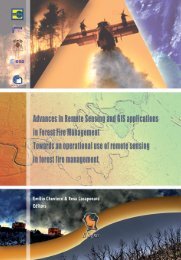EARSeL Newsletter - EARSeL, European Association of Remote ...
EARSeL Newsletter - EARSeL, European Association of Remote ...
EARSeL Newsletter - EARSeL, European Association of Remote ...
Create successful ePaper yourself
Turn your PDF publications into a flip-book with our unique Google optimized e-Paper software.
<strong>EARSeL</strong> <strong>Newsletter</strong> September 2002 - Number 51<br />
6<br />
thematic maps or models for land use and<br />
especially for forestry. There is a high demand<br />
for data in studies on, for example,<br />
urbanisation, forest health conditions monitoring,<br />
land use modelling, land cover<br />
change, etc. In order to identify and to find<br />
solutions for these research targets, the<br />
Workshop aims to bring together scientists<br />
from all countries, in order to exchange experiences.<br />
Workshop topics: thematic interpretation<br />
and classification <strong>of</strong> RS data; digital thematic<br />
maps creation for land use and<br />
forestry; monitoring <strong>of</strong> environmental<br />
processes; models integration; thematic<br />
GIS as a potential final result <strong>of</strong> operational<br />
thematic utilisation <strong>of</strong> RS data<br />
Abstracts due: October 31st 2002. Notification<br />
<strong>of</strong> acceptance: January 15th 2003. Payment<br />
<strong>of</strong> registration: February 15th 2003.<br />
Full paper due: February 28th 2003. Final<br />
programme: March 2003. More information<br />
will be published at: www.uhul.cz/workshop2003.<br />
SIG Imaging Spectroscopy<br />
The HySens group has just held a very successful<br />
field campaign acquiring hyperspectral<br />
imagery in Poland. The SIG is<br />
planning a Workshop to be held at DLR<br />
(German Aerospace Research Establishment)<br />
in May 2003. Details will be announced<br />
shortly.<br />
SIG Land Ice and Snow<br />
Following the successful Workshop held in<br />
Berne, Switzerland, in March 2002, this<br />
group is planning its next workshop, to be<br />
held in 2004, either at the Conference Centre<br />
in Abisko (Northern Sweden) where the<br />
facilities are excellent, or again in Berne.<br />
Dates will be announced shortly.<br />
2.3 UK retires GLORIA, prolific<br />
sea-floor sonar<br />
The Southampton Oceanography Centre<br />
(SOC), UK, an <strong>EARSeL</strong> Member Laboratory,<br />
announced recently that its successful<br />
sea-floor sonar, GLORIA (Geological LOng<br />
Range Inclined Asdic) has been gracefully<br />
retired, after surveying 5% <strong>of</strong> the world's<br />
oceans.<br />
GLORIA, which has been a big success<br />
story since her development in the early<br />
1970s to map sea-floor features in the deep<br />
ocean, is a long-range side-scan sonar providing<br />
the fastest known method <strong>of</strong> mapping<br />
the shape and texture <strong>of</strong> the sea-floor.<br />
She was developed and operated by the Institute<br />
<strong>of</strong> Oceanographic Sciences (now incorporated<br />
into Southampton Oceanography<br />
Centre). But, say SOC, with advances<br />
in technology since GLORIA was<br />
designed, it is time for her to retire from active<br />
service.<br />
One <strong>of</strong> the institution's three GLORIA vehicles<br />
left SOC at the end <strong>of</strong> July 2002 for<br />
transfer to the Science Museum at<br />
Wroughton, near Swindon, Wiltshire,<br />
which is part <strong>of</strong> the National Museum <strong>of</strong><br />
Science and Industry, where the large objects<br />
from the world <strong>of</strong> science and technology<br />
are stored and can be viewed by<br />
arrangement. Other exhibits include early<br />
computers and MRI scanners, large vehicles,<br />
and airliners.<br />
Keith Birch <strong>of</strong> SOC's Ocean Engineering<br />
Division said that "GLORIA was used extensively<br />
throughout the 1980s and 1990s.<br />
In particular, GLORIA undertook the<br />
world's largest sea-floor survey, mapping<br />
the entire USA Exclusive Economic Zone <strong>of</strong><br />
around seven million square kilometres<br />
over a period <strong>of</strong> seven years". In recognition<br />
<strong>of</strong> the USA survey, and more than 600<br />
scientific publications arising from the vehicle's<br />
outstanding success, GLORIA was<br />
awarded the Queen's Award for Technological<br />
Achievement in 1986.<br />
The survey system worked by towing<br />
GLORIA about 200 metres behind a ship<br />
and 100 metres below the surface. It produced<br />
digital image maps <strong>of</strong> the sea-floor.<br />
GLORIA could map large features and<br />
variations, down to roughly the size <strong>of</strong> a<br />
hockey pitch. New mapping vehicles, including<br />
SOC's TOBI (Towed Ocean Bottom<br />
Instrument), can survey to a much higher<br />
resolution, recording features down to the<br />
size <strong>of</strong> a minibus, and thus providing finer<br />
detail in its extensive sea-floor surveys.<br />
Acoustic remote sensing, with sonars<br />
towed from research ships or installed in<br />
their hulls, is still the current way <strong>of</strong> surveying,<br />
mapping, and studying ocean floor
















